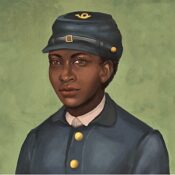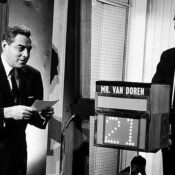Ross Perot started small. Sure, he may have been an entrepreneur and a billionaire and a two-time presidential candidate, but he got his start as a child in door-to-doors sales. One of the things that he sold, as he told us in 2008, was The Saturday Evening Post. In a piece about Rockwell’s autobiography, Perot discussed that background while professing his admiration for the work of the painter, saying, “I first learned about Norman Rockwell while I was selling The Saturday Evening Post magazines door to door, when I was six years old. I admired his paintings of The Four Freedoms and A Scout Is Reverent. Years later I became interested in, and purchased his paintings of, the Homecoming Military Heroes at the end of World War II.”
Perot, who died today at 89, had a career that went far beyond a childhood selling seeds and copies of the Post door-to-door. Born in Texas in 1930, Perot was an enterprising child and became an Eagle Scout. He went to Texarkana Junior College before entering the U.S. Naval Academy in 1949. He married Margot Birmingham in 1956, one year before he left the Navy; they would eventually have five children. He became a salesman for IBM before founding his own company, Electronic Data Systems, in 1962.
EDS took on the computerization of records for the U.S. Government, including Medicare files. Perot took the company public in 1968; its explosive stock growth would put him on the cover of Fortune. In 1984, General Motors bought EDS for $2.5 billion. It wouldn’t be the last Perot company to sell for a huge amount. In 1988, he founded Perot Systems Corporation, Inc. Both Perot and his son, Ross, Jr., would serve as CEO; Dell later bought that company for $3.9 billion in 2009.
Perot would have been famous enough for his business ventures, or for financing a rescue operation for two EDS employees trapped and imprisoned in Iran in 1979. But he permanently entered American consciousness when he ran for president as an independent candidate in 1992, relying on his outsider nature and business acumen to press for issues like balancing the budget and halting the outsourcing of American jobs to other countries. Though he temporarily led both Bill Clinton and George H.W. Bush in some polls, he eventually fell behind; Perot withdrew from the race, but re-entered in October, relying on self-financed infomercials on major networks to try to sway the public. Perot eventually took 18.9% of the popular vote (with no electoral votes), losing to Bill Clinton.
In 1995, Perot formed the Reform Party ahead of his 1996 run. While Reform Party candidate Jesse Ventura won the governorship in Minnesota, Perot only netted 8% of the presidential vote. The Reform Party faltered in the next few years due to infighting and an influx of conservative candidates like Pat Buchanan. Perot eventually withdrew from politics, though he would offer endorsements of George W. Bush and Mitt Romney for president.
Perot died from leukemia at the age of 89. In addition to awards he received for philanthropy and military and public service, Perot’s legacy remains the opening of the modern American mind to the possibility of third party candidates. Even if he didn’t win, he showed that it was possible to earn a place on the stage with the two major parties and demonstrated that even if we take certain things for granted, there might always be a different way to do things. We hope that his early experience selling The Saturday Evening Post was a positive one, and helped spur him to greater things.
Featured Image: Ross Perot. (Allan Warren; Wikimedia Commons via the Creative Commons Attribution-Share Alike 3.0 Unported license)
Become a Saturday Evening Post member and enjoy unlimited access. Subscribe now




Comments
Thanks for the reply Jeff! I’m surprised the tradition was going as late as September 1964. Having read Brian’s comments before mine, I also would have figured it to have gone away many years earlier. That’s a trip to think I’m old enough to have sold them myself at 7 years & 4 months and older!
That issue of the 19th had that neat cover of the cars coming down the assembly line and a feature on the beautiful ’65 models in color! Fantastic. Later were the issues featuring Carol Lynley, Jack Lemmon, mobiles, Sonny & Cher, the Beatles, Hippies, the burning draft card… Those last years of that version packed quite a punch, didn’t they? I’ll say they did! Only in the Sixties. I would have loved having that new bicycle too, and feel a little bad now I didn’t know about the opportunity then.
As late as 1964, (September 19th to be exact), the Post was inserting ads to recruit boys to sell Post subscriptions in their neighborhood. The ads were often accompanied by photos of a “dandy deluxe bicycle,” or the word “Money” in bold type.
Thanks so much for your thoughtful, prompt reply. Of course Jeff would be the go to guy! I’ll continue to check this feature for the answer on the ‘Post kids’ or see if it’s separate feature of its own in the near future. Thanks again! 🙂
Thanks for reading and for the question, gentlemen. I’m going to kick this one over to our resident historian and archivist, Jeff Nilsson; I’m positive he’ll know the answer. And Bob, I believe Jeff wrote about the transition from the old Post in the ’60s to the new version for the site, but he’ll probably find the link to that faster than I would. I’ll see what I can do.
Ross Perot was certainly one of the most unique and colorful men in American business and politics. I really believed in him and his ideas as a 3rd party candidate for President in 1992 that would shake things up for the better. He was a straight forward, can-do kind of guy that shared more than a few traits and commonalities with Lee Iacocca who (ironically) just passed away this month himself.
I put in a lot of hours in ’92 as a volunteer at my local Perot headquarters, but then he dropped out that July. Though disappointed, I resumed my support when he re-entered that October. I liked how he performed during the debates. Unfortunately, I knew it was all over with the Vice-Presidential debates. His running mate, Admiral James Stockdale, seemed unprepared and did not come off well, unfortunately. The rest of course is history.
Brian asks a good question here as to when the 20th century tradition of boys selling the Post (like Perot did) begin and end. I’d like to know myself, especially with the Post BEING the focal point of this feature. What about an article on just that? How/when it started, flourished, and what brought it to an end? A reply (here) would be appreciated please. Thank you.
There would be too much to comment on everything, so I’ll just stay with his having sold The Saturday Evening Post as a young boy. I’m sure it did help spur him on to the great accomplishments written of here on Mr. Perot.
I actually sold the Post too at age 9 in 1941. 6 would have been too young for me, but if anyone could have pulled it off that young, he’d be the one! I’ve wondered off and on over the years just when the practice or tradition of kids selling the Post door to door ended. I’ve never been able to find out. I’m guessing it may have ended during or shortly after Word War II. The early 50’s possibly. Could you tell me Mr. Brownfield? I know it’s likely way before your time, but maybe there’s some kind of information at the Post as to when it ended or started. I’d like to know both come to think of it. Thank you kindly.